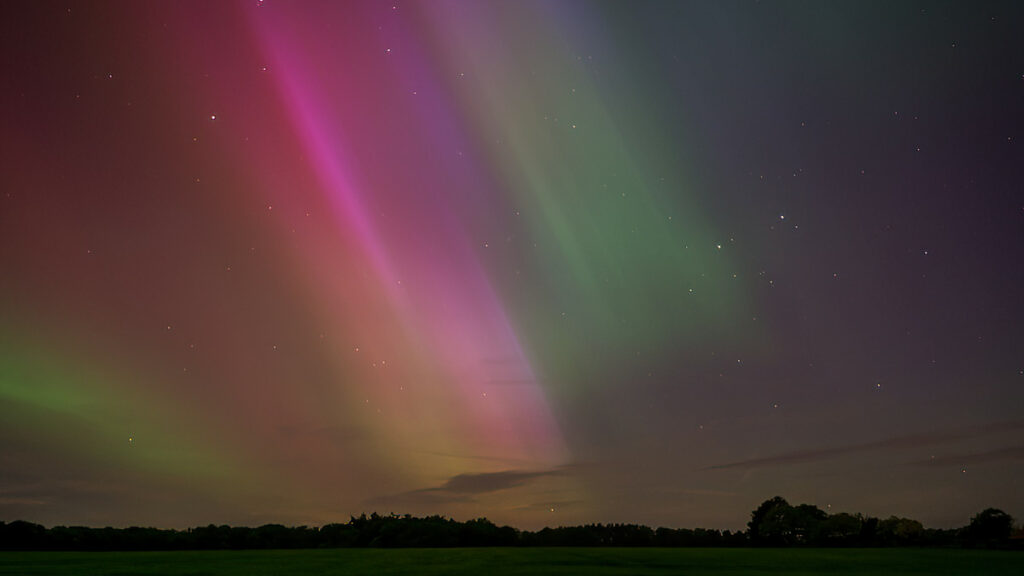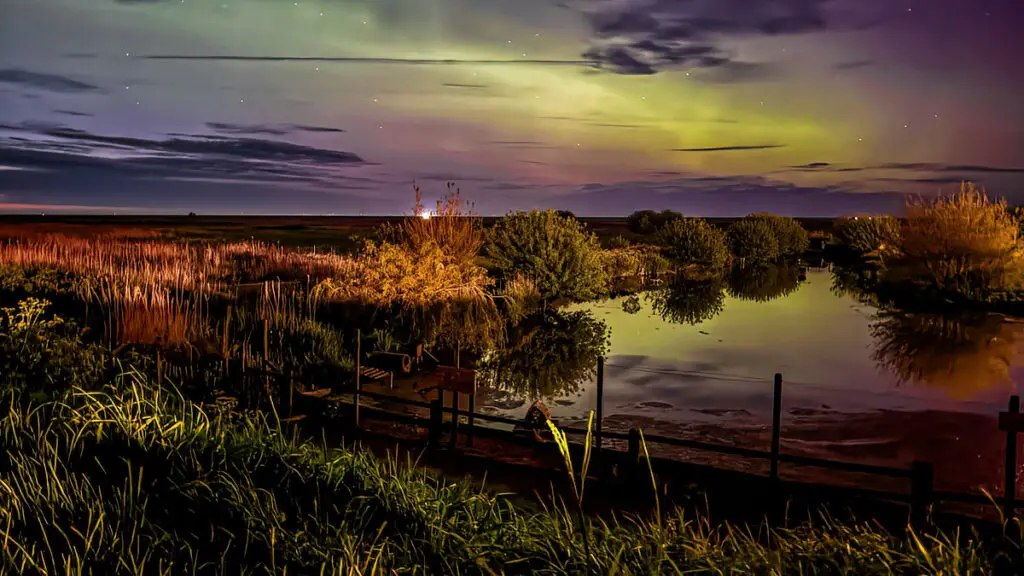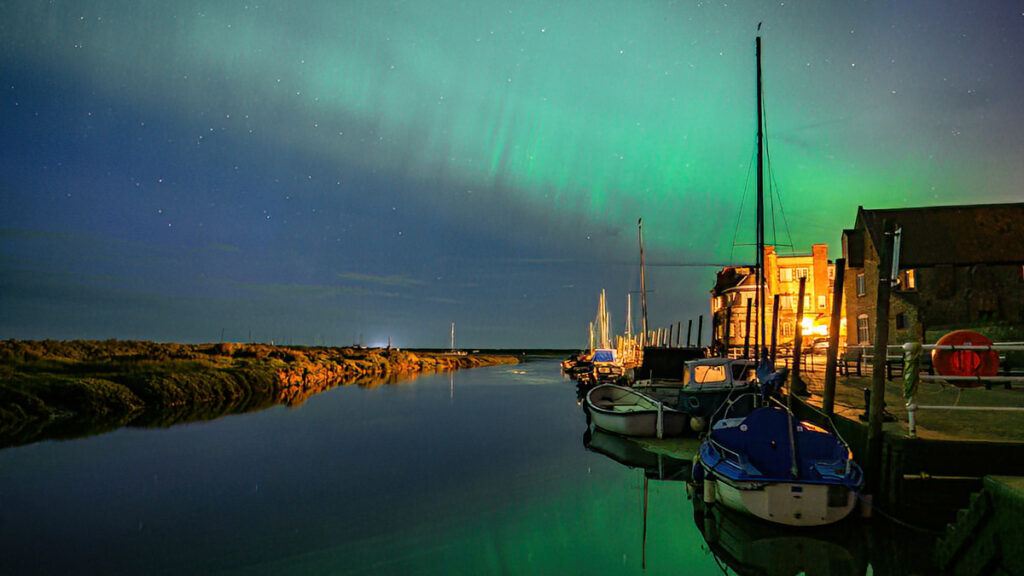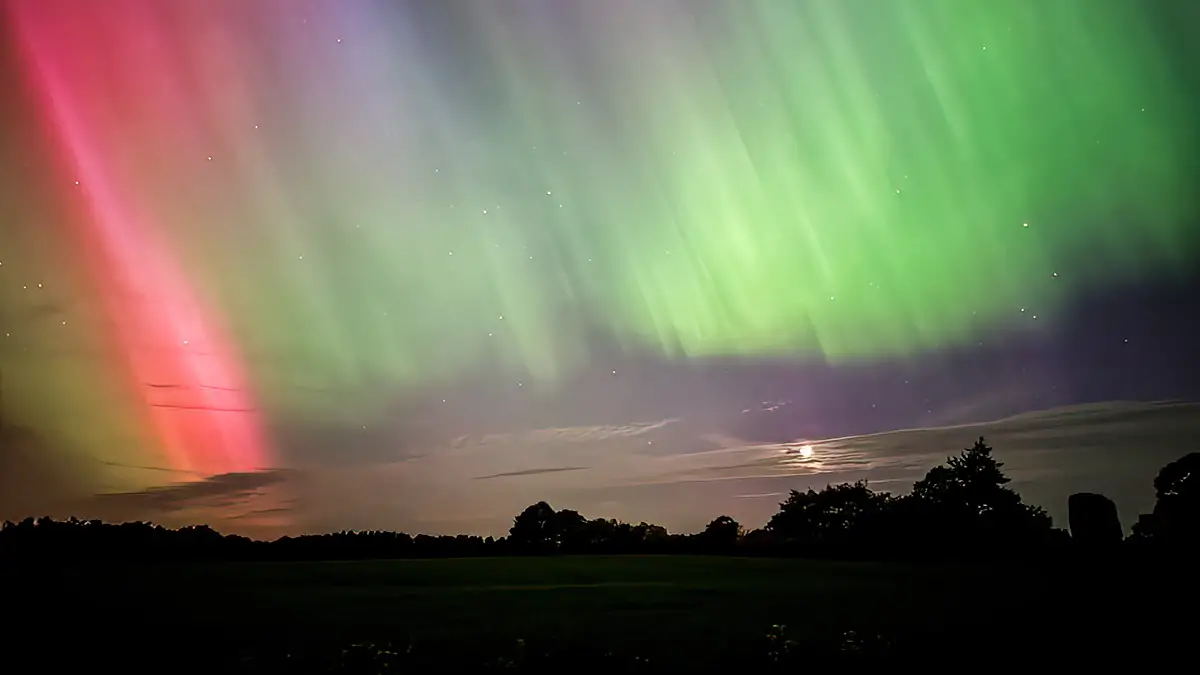While Norfolk may not be your typical aurora hotspot, those in the know have discovered we have been experiencing an unprecedented surge in Northern Lights sightings. Gone are the days when you had to trek to Scandinavia or venture to the remote wilderness of Iceland to witness the dancing lights of the Aurora Borealis.
Now, Norfolk offers an unexpected opportunity to catch this celestial spectacle within its charming countryside and coastline. However, before you rush outside with your camera in hand, it’s important to understand that the Northern Lights in Norfolk aren’t an everyday occurrence. Unlike the dependable seasons and tides, auroras follow their own mysterious rhythms.
Yet, with a little knowledge and a dash of optimism, you can increase your chances of experiencing this otherworldly light show in the heart of England. In this post, we’ll delve into how to see and photograph the Northern Lights in Norfolk.
Be sure to sign up for our email newsletter here so that we can share more interesting things to do in Norfolk.
Note: This post contains affiliate links. As an Amazon Associate, we earn from qualifying purchases. Please see disclosure for more information.

What are the Northern Lights?
The Northern Lights, also known as the Aurora Borealis, are a natural light display in the Earth’s sky, primarily seen in the high-latitude regions near the Arctic and Antarctic. These lights occur when charged particles from the sun, called solar wind, interact with the Earth’s atmosphere.
In simple terms, think of it as a beautiful light show caused by particles from the sun colliding with the gases in our planet’s air. When this collision happens, it creates colourful, glowing lights in the night sky, often with green and sometimes pink or purple hues. It’s like nature’s own fireworks display.

How to Find Out When You Can See the Northern Lights in Norfolk
To determine the best time to see the Northern Lights in Norfolk, we use the Glendale App, the world’s most accurate aurora alerting and forecasting app. You can’t get this app through the conventional app stores; instead, you need to visit the Glendale website here and complete a simple registration process. The great news is that this valuable tool is entirely free and comes without any distracting ads.
Don’t be discouraged by the complex data you may see on the Glendale App, especially if you’re new to tracking the Northern Lights. At the top of the app, there’s a user-friendly summary that breaks down all the scientific numbers into plain English, ensuring even beginners can grasp the information.
One of the most crucial numbers to monitor is the one in the substorm panel, measured in nanoTeslas (nT). This number signifies the strength of the aurora in the sky. You’ll want this number to show a ‘big drop,’ which means it should be big and negative. The more negative this number becomes (falling), the better the aurora, and the further south it can be seen. On the contrary, a rising number is not a good sign.
Keep an eye out for alert levels on the app, ideally aiming for ‘Red,’ or even better, ‘Purple’ which means Major Severe Extreme. These alert levels indicate the likelihood of witnessing a stunning aurora display. Lastly, when exploring the map, pay special attention to Norfolk. Look for green checkmarks over this region, as they signal favourable conditions for observing the Northern Lights here.
By utilizing the Glendale App and monitoring these key indicators, you can make well-informed decisions about when to venture out and search for the awe-inspiring Northern Lights in Norfolk. Remember, a big drop in substorm strength, high alert levels, and green checkmarks over Norfolk are all promising signs for a potential aurora show.
Where to Go to See the Northern Lights in Norfolk
As soon as the Glendale App hints at a possible Northern Lights show in Norfolk, it’s time to move. You’ll want to find a spot where you can catch the display before things change. Escaping light pollution is key for a clear sighting, so rural areas are your best bet. If you plan on taking photos of the aurora then you want a place with foreground interest like ruins, a church, windmill, or lighthouse.
Luckily in Norfolk that leaves plenty of options, so let me share our top spots to see the Northern Lights in Norfolk, based on our own adventures and some amazing photos we’ve spotted on social media.
Happisburgh

Happisburgh is a favourite spot for photographers during the day and at night. This tranquil village boasts an iconic red and white striped lighthouse, creating a picturesque setting. Once the sun sets, the stars emerge clearly, offering a fantastic celestial display.
You can use the main pay and display car park which is situated near the beach and north of the lighthouse. However, if you’re aiming for that perfect shot with both the lighthouse and the Northern Lights, be prepared for a short stroll.
Thornham
Thornham is a photographer’s dream, not just for its daytime charm but also for its after-hours allure. With the scenic Coal Barn and charming wooden stumps, Thornham offers an ideal backdrop for capturing the Northern Lights. The added bonus? The possibility of capturing stunning reflections in the nearby water.
You can find free parking by Staithe Lane just before you get to the Coal Barn, just be careful it can flood during some high tides.
Burnham Overy Staithe
For a captivating photo opportunity, look no further than Burnham Overy Staithe. This popular spot features serene waters, often dotted with boats, and is graced by the presence of an iconic mill.
There is some parking along E. Harbour Way or on “The Hard” (just take note of the tide levels) During the day, this is also the starting point for the ferry to Scolt Head Island.
Blakeney

While Blakeney might be best known for the impressive seal colony at Blakeney Point (viewable by boat), the Quay area steals the spotlight at night. The calm waters and the convenience of a National Trust car park make it an excellent spot for capturing the magic of the Northern Lights.
Camera Settings for Photographing the Northern Lights in Norfolk
Note: Depending on the strength of the aurora, these tips for photographing the Northern Lights may not be required. On 10 May 2024, any long exposure settings were capturing the magic and we were even able to take photos on the phone without a tripod.
When it comes to camera settings for optimal aurora photos, there’s no one-size-fits-all solution. It varies based on factors like your camera model, the aurora’s strength, ambient light, and more. Our most successful results came from using a 16mm prime lens on an APS-C crop sensor camera (equivalent to 24mm on a full-frame camera), set at a wide aperture of F2.8, a 15-second exposure, and an ISO of 3200.
For a stellar aurora shot, opt for a wide-angle lens with the widest aperture possible—ideal choices are F1.8 or F2.8. Experiment with shutter speed in the range of 2 to 15 seconds, adjusting based on the aurora’s intensity. When it comes to ISO, don’t shy away from higher values; a range around 2500 to 3200 is commonly used and can yield fantastic results. Just know the limits of what your camera can manage before the photo becomes unusably noisy.
Even if you don’t own a high-end camera, capturing the Northern Lights on your phone is entirely possible. While personal success may vary (I had mixed results), I’ve come across others who’ve taken stunning aurora photos with their phones.
Consider using apps like LongExpo Pro or Northern Lights Photo Taker App, as they might assist in optimizing your phone’s camera settings for capturing the ethereal beauty of the auroras. I’ll be trying them out myself and will report back on their effectiveness.
Tips for Chasing the Northern Lights in Norfolk
Considering a Northern Lights quest in Norfolk? These tips could prove invaluable for your aurora-chasing expedition.
- Keep an eye on the Aurora app and be prepared to set off on short notice.
- Also be sure to check the weather conditions. Clear skies will significantly enhance your chances of witnessing the Northern Lights.
- Aim for nights with minimal moonlight to maximize the visibility of the auroras. A new moon or crescent moon phase is ideal.
- Before the night of the aurora, scout potential locations during the day. Familiarize yourself with the surroundings, to make it easier to navigate in the dark.
- Aurora displays can be unpredictable. Be patient and give yourself ample time, as the lights might not appear immediately.
- Double check that you are looking north! Although if there is a strong aurora, you may be able to see it overhead and in other directions too.
- Dress warm, you might be out in the cold for awhile. A warm drink is also a good idea.
- You will need a tripod if you want to get good photos. If you don’t have one, you can find options for a camera tripod here or a mobile phone tripod here.
- Cold temperatures can drain camera and phone batteries quickly. Carry extras (and a portable battery power bank) to ensure you don’t miss any magical moments.
- Bring a torch, it will be dark. You can use the one on your phone in a pinch, if you are not using your phone to take photos.
Disclosure: This post contains affiliate links. This means we will receive a small commission for some purchases made using links in our blog with no additional cost to you. Please be assured we would not promote any product unless we believe that our readers will also benefit. The commission does not influence the editorial content of this site.


